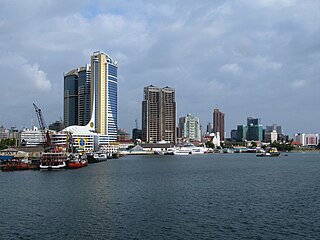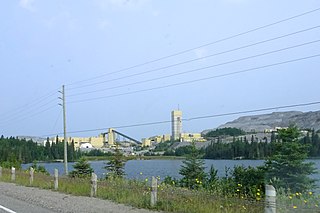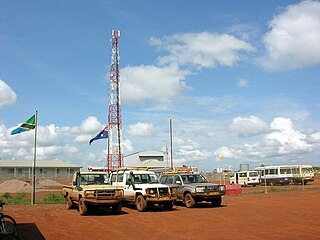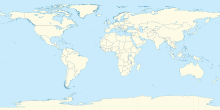
The economy of Tanzania is a lower-middle income economy that is centered around Manufacturing, Tourism, Agriculture, and financial services. Tanzania's economy has been transitioning from a planned economy to a market economy since 1985. Although total GDP has increased since these reforms began, GDP per capita dropped sharply at first, and only exceeded the pre-transition figure in around 2007.

Barrick Gold Corporation is a mining company that produces gold and copper with 16 operating sites in 13 countries. It is headquartered in Toronto, Ontario, Canada. It has mining operations in Argentina, Canada, Chile, Côte d'Ivoire, Democratic Republic of the Congo, Dominican Republic, Mali, Papua New Guinea, Saudi Arabia, Tanzania, the United States and Zambia. In 2023, it produced 4.05 million ounces of gold at all-in sustaining costs of $1,335/ounce and 420 million pounds of copper at all-in sustaining costs of $3.21/pound. As of 31 December 2023, the company had 77 million ounces of proven and probable gold reserves.
AngloGold Ashanti Limited is an independent and global gold mining company with a diverse portfolio of cooperation, projects, and exploration activities, formed in 2004 by the merger of AngloGold and the Ashanti Goldfields Corporation. As of 2022, it was a global gold producer with 21 operations on four continents, listed on the New York, Johannesburg, Accra, London and Australian stock exchanges, as well as the Paris and Brussels bourses, and left the Johannesburg exchange in 2023. As of May 2023, it was the world’s fourth-largest gold miner, with assets in Ghana, Australia, the US, and Argentina.
Goldcorp Inc. was a gold production company headquartered in Vancouver, British Columbia, Canada. The company stood among the largest gold producers in the world, employed about 15,800 people worldwide, engaged in gold mining and related activities including exploration, extraction, processing and reclamation. Goldcorp’s operating assets included eleven mines in North and South America.

The Fimiston Open Pit, colloquially known as the Super Pit, is an open-pit mine in Australia. It was Australia's largest open cut gold mine until 2016, when it was surpassed by the Newmont Boddington gold mine, also in Western Australia. The Super Pit is located off the Goldfields Highway on the south-east edge of Kalgoorlie, Western Australia. The pit is oblong in plan view and is approximately 3.5 kilometres long, 1.5 kilometres wide and over 600 metres deep.

The Geita Gold Mine is an open pit gold mine located in the Geita District of the Geita Region of Tanzania. It is operated by AngloGold Ashanti.
The Granny Smith Gold Mine is a gold mine 21 kilometres (13 mi) south of Laverton, Western Australia near Mount Weld and operated by Gold Fields.
The Jundee Gold Mine is an active gold mine in Western Australia, approximately 47 km north east of the town of Wiluna, owned by Northern Star Resources.
The Darlot-Centenary Gold Mine is a gold mine located 58 km east of Leinster, Western Australia.
The Lawlers Gold Mine is a gold mine located 23 km south west of Leinster, Western Australia, owned by Gold Fields. Gold Fields purchased the mine in late 2013 and combined it with its nearby Agnew Gold Mine. The process plant of the mine was subsequently sold and dismantled while no mining was carried out at Lawlers.
The Kanowna Belle Gold Mine is a gold mine 19 kilometres (12 mi) north-east of Kalgoorlie, Western Australia, near the ghost town of Kanowna.
The Plutonic Gold Mine is a gold mine located 82 km east-northeast of Peak Hill, Western Australia.
The Mount Morgans Gold Mine is a gold mine located 37 km west-southwest of Laverton, Western Australia.
Acacia Mining is a gold mining business operating in Tanzania, with exploration properties in Kenya, Burkina Faso and Mali. It is listed on the London Stock Exchange and the Dar es Salaam Stock Exchange and is a constituent of the FTSE 250 Index until it was re-acquired by Barrick Gold in September 2019.
The Sekenke Gold Mine was an underground gold mine in the Singida Region of Tanzania.
Tulawaka Gold Mine was a combined underground and open pit gold mine located in the Biharamulo district, in the Kagera Region of Tanzania. It is operated by African Barrick Gold, who owned 70% of the mine. The remaining 30% was owned by MDM Mines.
Bulyanhulu Gold Mine is an underground gold mine in the Shinyanga Region of Tanzania, located 55 kilometres south of Lake Victoria. It is one of three gold mines owned by Acacia Mining plc, formerly African Barrick Gold plc, a company owned by Barrick Gold, which is listed on the London Stock Exchange, and operates in Tanzania. Acacia also owns Buzwagi Gold Mine and the North Mara Gold Mine.

Buzwagi Gold Mine is an open pit gold mine in the Shinyanga Region of Tanzania, located 6 kilometres southeast from the town of Kahama. It is operated by Acacia Mining.
North Mara Gold Mine is a combined open pit and underground gold mine in the Tarime District of the Mara Region of Tanzania. It is one of three gold mines of Acacia Mining plc, a company listed on the London Stock Exchange, that operates in Tanzania, the other two being Bulyanhulu and the Buzwagi Gold Mine.
The Golden Pride Gold Mine is an open pit gold mine located in Nzega District of the Tabora Region in Tanzania. Operated by the Australian mining company Resolute Mining, Golden Pride was the first modern commercial gold mining project developed in Tanzania since the country's formation in 1964.







